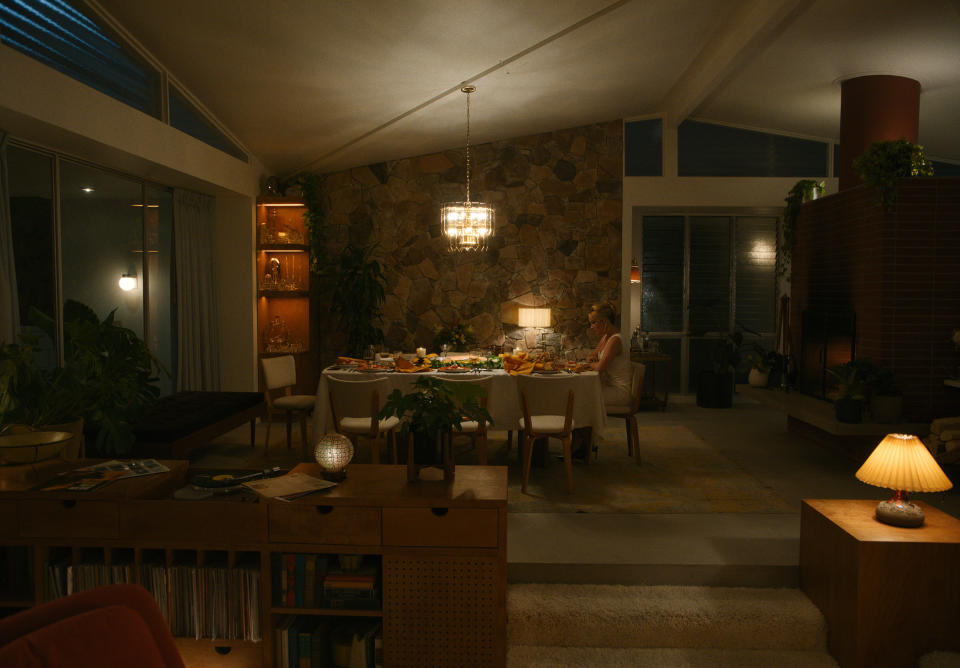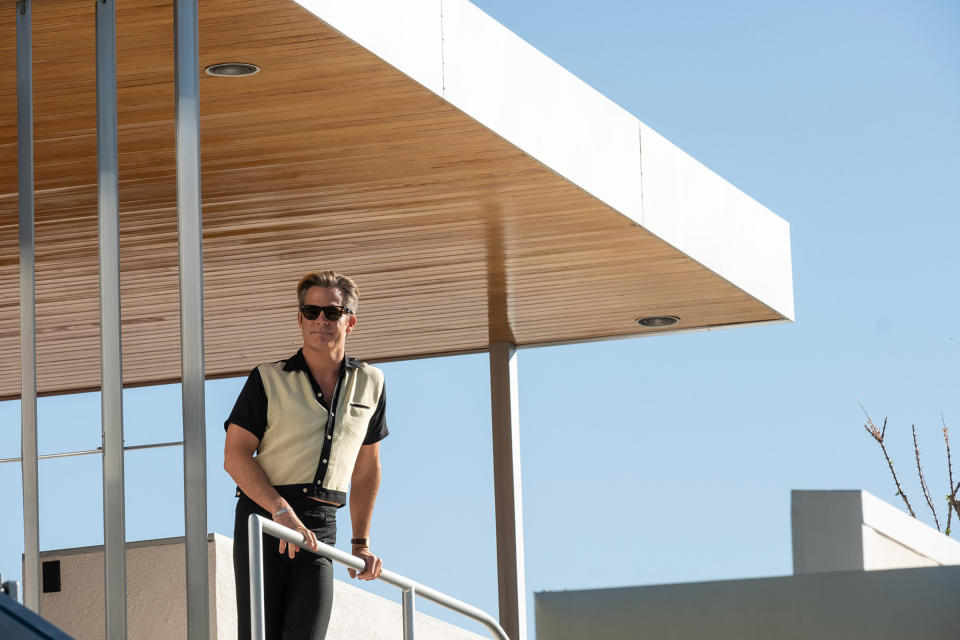The Only Thing ‘Don’t Worry Darling’ Doesn’t Have to Fret Is Its Immaculate Production Design

- Oops!Something went wrong.Please try again later.
- Oops!Something went wrong.Please try again later.
In “Don’t Worry Darling,” young housewife Alice (Florence Pugh) lives with her husband Jack (Harry Styles) in a 1950s housing development that, for both the characters and the audience, is one of the most inviting and luxurious environments to be seen in a Hollywood movie since the heyday of Vincente Minnelli and Douglas Sirk. That was every bit the intention, according to production designer Katie Byron. “There was a lot of talk about what a modern version of a 1950s utopia would be,” she told IndieWire.
From the beginning, that meant shooting in Palm Springs, where Byron took inspiration not only from the rich architecture by legends like Albert Frey and Richard Neutra, but also from the history of debauchery underneath the placid surfaces. “There was a lot of investigation into The Rat Pack and how Palm Springs became this place where the Hollywood elite — as well as artists and outcasts — could go and have these parties and go really wild,” Byron said. “It was much more hedonistic than what you would think when you think of a ’50s utopia.”
More from IndieWire
The film’s sexual energy adds to the alluring nature of its world, but as with many of those Minnelli and Sirk movies, the lustrous surfaces of Olivia Wilde’s sophomore feature mask disturbing tensions. That led to one of Byron’s greatest challenges, and the movie’s greatest achievement, as she had to design sets that would be “perfect” in their way yet subtly convey a growing sense of unease that ultimately takes over “Don’t Worry Darling.” The house in which Alice and Jack live is a case in point: a radiant, colorful jewel box that eventually becomes a trap.

Courtesy of Warner Bros. Picture
In order to create a house that would serve all of the story’s needs, Byron relied on materials that could be playful and whimsical yet dangerous, like glass. “Glass is opulent, it’s precious, it’s beautiful,” Byron said. “It’s also scary. It allows for surveillance. The walls can shatter. The idea is that this house can flip-flop between being safe and unsafe, and a lot of that is in the architecture — windows looking in on the other U-shaped house windows, looking into other rooms, that create a sense of surveillance. Not from the outside world, but surveillance from your spouse. Who’s in the other room?”
Although many commentators have zeroed in on the candy-colored, pastel nature of the film’s universe, “Don’t Worry Darling” actually has as many earth tones, blacks, and creams in its design, anchoring the poppier colors in a rich, dense palette that finds its way into every aspect of the design. “A lot of the color comes from a sense of opulence,” Byron said. “The light fixtures are colored glass, the crystal has color. It’s not this flat color palette. Every color feels like it has variations of color beyond it. Olivia and I conceived the houses to be dark and tempting and sensual.”

Merrick Morton
While Palm Springs was a playground for Hollywood’s A-list in the 1950s, it also served as an incubator for some of the era’s most trailblazing modernist architects. Many of the most striking locations in “Don’t Worry Darling” are iconic structures like Neutra’s Kaufman House, which was made famous by Slim Aarons’ “Poolside Gossip” photo, and Frey’s city hall, which stands in for the exterior of a fitness center. “These are legendary buildings to me,” Byron said. Shooting in the creations of her heroes, most of which are rarely if ever made available for film production, gave Byron an added jolt of inspiration. “Getting to push things into this playful, provocative aesthetic, it felt like we could start breaking the rules in the same way that those modernist masters did.”
Byron credited location manager Chris Baugh with finding one unique building after another. “He was exceptional and just kept giving us cool spots to film in,” she said. “I wish the script had many more locations, because he was such a legendary location manager.” The only part of the experience that Byron didn’t enjoy, both during the location scouts and the shoot, was the limited interaction demanded by COVID. Luckily, Byron and Wilde and cinematographer Matthew Libatique developed a shorthand that transcended the physical limitations. “It felt like friends making a movie, which was really important because when you’re masked and in different cars and everything it’s hard to collaborate with new people and get to know them. You have to be really intimate to be far out and imaginative.”
Best of IndieWire
New Movies: Release Calendar for September 23, Plus Where to Watch the Latest Films
Martin Scorsese's Favorite Movies: 50 Films the Director Wants You to See
Sign up for Indiewire's Newsletter. For the latest news, follow us on Facebook, Twitter, and Instagram.

